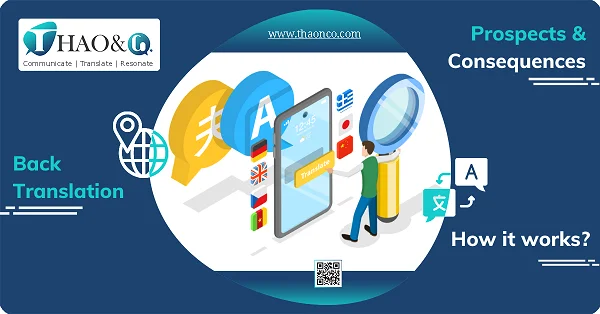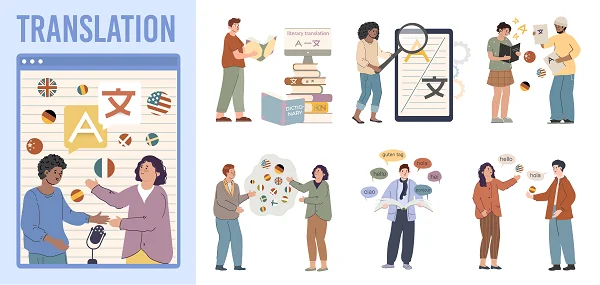Back translation is a widely used method aimed at managing the quality of translations. When and where is this type of translating typically applied, and what benefits does it bring? Please join Thao & Co. to gain a deeper insight into it through this article.
What is back translation?
Definition
Back translation is the opposite of forward translating. It refers to translating a text back into the original language. The process is carried out as follows:
- ● Step 1: A translator translates the original document into the required language.
- ● Step 2: Another translator, who has not been acquainted with the original text, performs back translation to the original language.
- ● Step 3: After the back translation has been completed, a reviewer will compare both versions and annotate any differences, ambiguities, or potential issues.
- ● Step 4: The translations will then be sent to the client along with notes highlighting the differences and proposed solutions.
For many, this may come across as a redundant step. In reality, it is a crucial process for evaluating the translation’s quality and preventing errors.
Pros and Cons
Back translating is applied in various fields due to the following advantages:
- ● Reduce translation errors
- ● Enhance translation accuracy
- ● Assists clients unfamiliar with the target language in understanding and controlling translation quality
However, back translating also has some drawbacks:
- ● Additional time and cost
- ● Differing from the forward translation version in elements such as: structure, context, culture, and more, which may lead to confusion despite the forward translation effectively conveying the meaning of the original text.
For these reasons, evaluators for forward and back translations must be experienced linguists, well-trained, and sensitive to linguistic nuances.
When is back translation required?
Back translating plays a crucial role in the following cases:
- ● Translating documents in heavily regulated industries such as medical, insurance, and finance, where risk management is crucial to avoid serious consequences.
- ● Accuracy in content and terminology usage in the translation is prioritized over creativity.
- ● The source text is highly creative or emotionally rich.
- ● Required by corporations, organizations, or government agencies as a mandatory step in translation services.
To meet requirements for accuracy, tone, word choice, and cultural appropriateness for specific targets, the back translating method is commonly used in the following fields:
- ● Creative translation: Marketing materials, advertisements, etc.
- ● Medical documents: Pharmaceutical inserts, medical equipment instructions, clinical trials and research, etc.
- ● Market research: Survey results, questionnaires, research findings, etc.
- ● Legal documents: Contracts, legal texts, case files, legal complaints, etc.
- ● Financial documents: Financial reports, legal documents, audit documents, etc.
- ● Technical, manufacturing, and product documents: Operation manuals, import-export documentation, product packaging, etc.
This type of translating can be considered an effective quality management method for the following reasons:
- ● Help clients control translation quality: Clients who are unfamiliar with either language may find it challenging to assess the accuracy of the translation. Back translation provides clients with opinions from expert evaluators for a comprehensive understanding of the translation.
- ● Ensure the accuracy of the translated content
- ● Increase the overall quality of the Linguistic Quality Assurance (LQA) process
- ● The back translation version can be used for legal reference purposes
- ● The back translation can be used as reference material for future translation projects
Practical examples of back translations
Let’s take the famous KFC slogan into consideration: “It’s Finger Lickin’ Good.” When introduced to the Chinese market, this slogan was translated incorrectly as “Eat Your Fingers Off.” This error was then detected and corrected promptly through the application of the back translating process.
Another case of translating error discovered through the process involves the slogan of Parker Pen’s ballpoint pen product. To emphasize the product, the brand chose the slogan: “It won’t leak in your pocket and embarrass you.” However, when translated for use in the Spanish market, this slogan took on a completely different meaning: “It won’t leak in your pocket and make you pregnant.”
Where to find credible translation services?
This type of translating is a complex process, involving many requirements for both the evaluator and translator. Therefore, when seeking services of back translating, it is advisable to choose an experienced agency.
For professional translations with accurate content and proper format, you can consider Thao & Co. We manage a team of native linguists with extensive experience and confidence in transaltion and proofreading services.
Thao & Co. committed to providing you great experiences with:
- ● Delivering accurate translations with the original format preserved
- ● Providing translation solutions in more than 50 languages, from common to rare: English, Chinese, French, Arabic, Korean, Japanese, Vietnamese, and more.
- ● Providing back translation services and evaluation results along with additional language solutions when requested.
- ● The forward and back translation processes are carried out by our highly specialized linguists with many years of experience.
- ● Expertise in various fields: Legal, Medical, Advertising and Marketing, Technology, Manufacturing, and more.
- ● A scientific, transparent workflow with meticulous quality control.
- ● Clients can monitor project progress and interact with translators through Thao & Co.’s proprietary platform.
Although back translating is considered a time-consuming process, when executed correctly, it serves as a powerful tool for quality control in the process. Therefore, when undertaking back translating, it is recommended to work with a professional agency that has a team of native-speaking linguists and follows a transparent, professional workflow to objectively assess the services.
For further assistance, please leave your information on our Get a Quote page, and we will contact you for prompt consultation!


